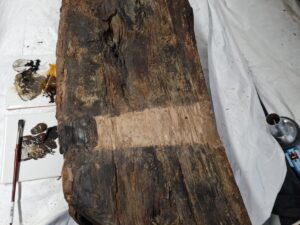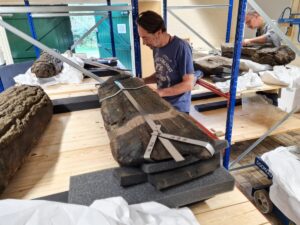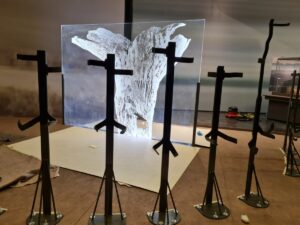The blockbuster World of Stonehenge exhibition at the British Museum was a phenomenal success. We were thrilled and trepidatious when the British Museum requested to loan the palisade timbers from “Seahenge”, as we knew it would take a great deal of work, both practical and logistical, to make it happen. Holme I timber circle dubbed “Seahenge” by the National media, was a standout star of the show so we thought our work on the loan was worthy of a mention. For those not so familiar with our own display of the Holme timber circle, only half the footprint of the circle- twenty-six timbers 25-52 are on display at King’s Lynn Museum, whilst the other 28 timbers are in storage. Not wanting to diminish the existing display entirely, a compromise was reached to lend nine of the stored timbers, alongside six from our current display, including the forked timber which is the proposed access point or doorway to the circle.
Although all the timbers had been through the same conservation treatment programme, the timbers left in storage were not in a condition to display or travel, requiring a considerable amount of additional treatment from conservators Debbie Harris, Jonathan Clark and conservation technician Alice Forkes. During the excavation of the circle in 1999 the timbers were all sampled for dendrochronology, a scientific dating technique that left each timber with a significant wedge-shaped gap. As with the current display timbers, the decision was made to ‘gap fill’ the dendrochronological cuts so that they would not distract or be mistaken for an original feature.

Conservator Jonathan Clark prepares and sands and texturises the glass microballoon fills ready for colour matching
The timbers are incredibly vulnerable, particularly the surviving bark on the outer facing side of the timbers. Bark being more fibrous than wood suffers differential shrinkage during the drying process. For the most part, detached bark was pinned on with stainless steel pins. In some instances, reversible adhesives and fillers were required, to secure and support more vulnerable areas. With each timber weighing between 30-50 kilos, fragile bark on one side and the gap fills on the other, the timbers are difficult to handle and transport. Getting the timbers from a horizontal position to the vertical was a challenge, requiring significant peoplepower and skill to avoid damage to the fragile bark or fills. We are hugely grateful to the British Museum team for their assistance with this.

The gap fills were painted out to give the appearance of wood but not to disguise
In contrast to the Kings Lynn gallery, the timbers at the British Museum were on open display, this is because it was a four-month temporary exhibition rather than a long-term gallery installation. Expert steelwork specialist, Simon Meiklejohn, undertook the task of creating individual steel mounts that perfectly fit each timber, ensuring they were safely supported on display. Debbie and Jonathan worked closely with the British Museum installation team to condition check and install the timbers. The timbers required some further cosmetic work once vertical to ensure the bark and fills were completely stable for the duration of the show.

Mount maker Simon Meiklejohn begins the preparatory work for creating the steel mounts for display

The mounts safely installed awaiting the palisade timber install

The reverse side of the mounts encapsulating the timbers perfectly during their loan to the British Museum
The henge took prime position in the centre of the exhibition. It followed the story of Britain and Europe from 4000 to 1000BC and concerned the restless and highly connected age of Stonehenge- a period of immense transformation and radical idea that changed society forever. Huge thanks go to the Le strange estate for granting permission for the loan to go ahead, our counterparts at the British Museum, our colleagues in Collections Management, Kings Lynn Museum, and technician duo ‘This way Up’ for all their help.

